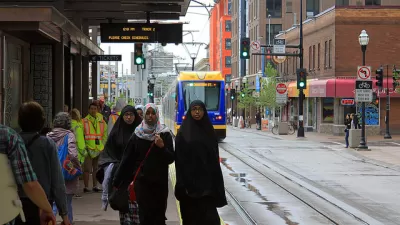Morgan Clendaniel reports on a Minneapolis artistic intervention, Urban Plant Tags, that call attention to often overlooked amenities in the built environment.
Urban Plant Tags, a project of Minneapolis-based Carmichael Collective, are designed to look like oversized versions of the tags that accompany potted plants. These tags, however, are placed next to amenities such as street lights and park benches. Care instructions serve as a reminder that the infrastructure that populates your neighborhood doesn't take care of itself.
"Change light bulb annually", and "Occasionally wipe clean" are among the descriptions of care required. Clendaniel believes the tags serve as a creative reminder, while also connecting people to their neighborhood in a new way. From his point of view, "the project does help foster a sense that things like fire hydrants or stop signs don't simply sprout from the ground at random, and that to create a sense of place and community, we should all be a little mindful of what makes up the place where we live."
Thanks to Jessica Brent
FULL STORY: Urban Plant Tag Advise You to Care for Your Neighborhood

Trump Administration Could Effectively End Housing Voucher Program
Federal officials are eyeing major cuts to the Section 8 program that helps millions of low-income households pay rent.

Planetizen Federal Action Tracker
A weekly monitor of how Trump’s orders and actions are impacting planners and planning in America.

The 120 Year Old Tiny Home Villages That Sheltered San Francisco’s Earthquake Refugees
More than a century ago, San Francisco mobilized to house thousands of residents displaced by the 1906 earthquake. Could their strategy offer a model for the present?

HSR Reaches Key Settlement in Northern California City
The state’s high-speed rail authority reached an agreement with Millbrae, a key city on the train’s proposed route to San Francisco.

Washington State Legislature Passes Parking Reform Bill
A bill that would limit parking requirements for new developments is headed to the governor’s desk.

Missouri Law Would Ban Protections for Housing Voucher Users
A state law seeks to overturn source-of-income discrimination bans passed by several Missouri cities.
Urban Design for Planners 1: Software Tools
This six-course series explores essential urban design concepts using open source software and equips planners with the tools they need to participate fully in the urban design process.
Planning for Universal Design
Learn the tools for implementing Universal Design in planning regulations.
Ada County Highway District
Clanton & Associates, Inc.
Jessamine County Fiscal Court
Institute for Housing and Urban Development Studies (IHS)
City of Grandview
Harvard GSD Executive Education
Toledo-Lucas County Plan Commissions
Salt Lake City
NYU Wagner Graduate School of Public Service




























